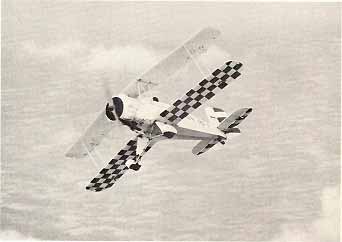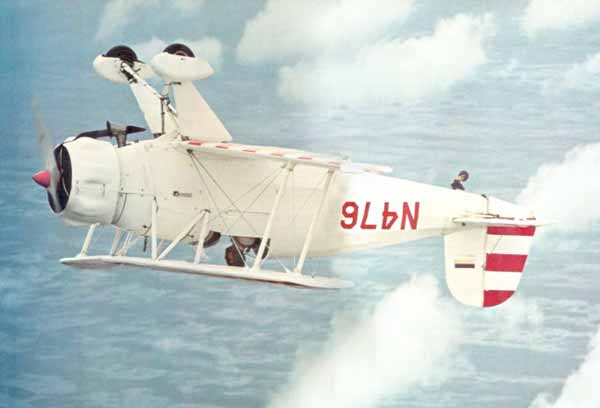PAGE TWO
The horizontal tail surfaces look pretty odd at first because
they're so fat and have an exaggerated airfoil section. Also, the elevators
are hinged off the centerline, like a flap, giving it a reverse pendulum
motion.
An antique airplane wouldn't be complete without an antique engine,
and they really have one in the Siemens-Halske SH-14A4.
The Siemens is a 160-hp German radial that was to Germany what our
Kinner was to us. It's a reliable engine that uses a genuine "spitzergausser" carburetor
(honest!) that was a forerunner of fuel injection. It has a self-starter
that uses an externally attached compressed air bottle to pump up one
cylinder, but it's usually less trouble to prop the plane.
A program is under way in Germany now to fit a 220-hp Franklin
to this same airframe, using a radial cowl so as not to spoil its looks.
The 220-hp would give it a power loading in the area of 6 pounds/hp,
and that puts it in the Mustang and Focke-Wulf class. It should be
a piece of biwinged dynamite.
Bill pointed out the cockpit controls as he helped me strap
in. The cockpit is old-fashioned, too, like a steamboat, with all the
controls big and out-sized, with large, easily read English placards
and instruments. The tailwheel lock sticks out of the left side of
the cockpit like a tiller bar.
 |
The double swept wings of
the Jungmiester contribute a lot to the way it snaps. |
Thomas was careful to explain the fuel system. The fuel is controlled
by a large lever that looks as if it should be lowering the plow on
a Massey-Fergusen, but it fits into three large detents labeled: off,
normal, and acrobatic. The acrobatic position feeds through a flop
tube, and all takeoffs and landings are made with the lever reading
normal, in case the flop tube gets kinked. A smart idea.
The stick is so unusual that it's almost comical. It doesn't feel
drastically different, but it really looks weird. Most of
the stick comes straight out of the floor, but then a piece of half-inch
rod shaped like an “L” is stuck on top of it, with a round
ball on the short end of the L. It looks as if the engineers discovered,
after they were all done, that the stick was in the wrong place and
they had to make a quickie fix to move it back.
This was to be my first flight in a single-seat biplane, and I had
a hard time suppressing a ridiculous grin. (Ed.
Note: I’m still
grinning from this flight!)
Off and closed! Thomas pulled it through, the impulse coupler making
a loud mechanical clacking sound as it rotated. Contact! The blue smoke
sputtered past, and I lost my battle with the grin.
Between the cabane struts and the cowling, there isn't a lot to see
straight ahead, so I eased out to the runway in a gentle S motion.
The steerable tailwheel is so positive that it could almost be considered
sensitive. I kicked rudder as if I were taxiing a Citabria
and nearly totaled a gas pump. Because the tail is so short and the
control system tight, there is absolutely no lag in response when a
rudder is depressed. This is something worth remembering on landing
roll—don't get too anxious and overcontrol.
I checked the mags and cleared traffic by swiveling my head. Visibility
is completely unrestricted up and to the rear. Takeoff was surprisingly
uneventful; I was paying special attention to
the rudder so that I wouldn't overcontrol. Also, I made a mental note
which cowl bump rested on the horizon so I'd know the three-point attitude
when I came back to land. It tracked so straight, and lifted off so
early, that I never even had a chance to make a mistake.
The second the controls came alive and I cleared ground, I knew this
was a real piece of flying machine under me. I twisted and looked at
the tiny airplane around me and laughed out loud. I wiggled the funny-looking
stick, watched the double ailerons react, and felt the airplane jump.
Oh man, this was real flying, and I hadn't even left the pattern yet!
I try to be methodical about the way I evaluate airplanes, but when
I get my hands on a bird like this, my logical approach is forgotten.
The second I got altitude, I pulled the nose up, fed in
some aileron, and rolled the Everglades up into a ball. Slow rolls
are my favorite maneuver, and the Jungmeister does them beautifully.
Four-, six-, eight-point rolls, all with the same effortless ease.
At first I had trouble overshooting my points because the ailerons
are so very light, response is quick, and stick travel is short. I'd
smash in aileron as if I were in a Citabria and be inverted before
I knew what happened.
Only a few minutes are required to get accustomed to the way the airplane
responds. It just takes an inch or so of stick to do rolls, and the
airplane reacts the second it feels any pressure at all. I had to be
careful or all my maneuvers would have been twitchy. The elevator and
rudders are just as responsive as the ailerons,
but the pressures are just a shade heavier, which still makes them
lighter than any U.S. design I've ever flown.
There's a lot of noise that you don't really notice until it disappears.
As I pulled up into my first loop, things got quiet in a hurry, as
the speed fell off and the wind went out of the wires. As soon as the
nose is brought up, the airspeed starts for the cellar. More power
would help, but most of the problem is too much stuff sticking out
into the wind. That's part of the charm of biplanes.
One of the best-known parts of the Jungmeister legend is the way the
plane is supposed to snap. Well, I'm here to tell you that anything
you hear about Jungmeisters and snap rolls, you can believe! I snapped
it first with no ailerons, using back stick and rudder,
as most ships are snapped, and it went around pronto. I snapped it
using ailerons, bringing the stick back into the corner, and it blurred
the horizon. Civilized airplanes shouldn't act this way. It starts
and stops so fast and cleanly that half and quarter snaps are child's
play.
Inverted flight is really a blast. It will cruise along on its back,
hands off, making it easy to concentrate on putting real precision
into the turns. It's a little nose-high, to make up for all that drag
(and a nearly flat airfoil), but it's not objectionably
high.
I figured that as long as I was on my back, I'd try an outside loop
from the bottom. I dropped the nose to get 150 mph (I found later I
should have had 160) and pushed. Things went wrong from the start.
At three negative Gs, my entire head was sticking outside
the windscreen and I couldn't see a thing. Thomas had warned me to
put the seat at the bottom, but it was too late by then. I got most
of the way around and was about 45-degrees nose-high, right side up,
when everything happened at once: It hit an outside stall, the horizon
zipped around, and I recovered in an inverted dive. I half rolled out,
swallowed my heart, and tried to figure what had happened.
Things had happened pretty fast, but it looked as if the biplane had
done an outside snap roll all by itself. I figured, okay, if it wants
to play that game—and I rammed the stick forward and stomped
left rudder. Wham! Two negative Gs and I found the Jungmeister
snaps almost as fast outside as it does inside, but my neck stretches
a lot further. Some fun!
I spun inside and out and found it spins slower than either a Citabria
or a 150. You'd really have to be a klutz to spin this one in from
altitude.
The Bu-133 D-1 was built to do aerobatics, but it's also a gas of a
Sunday-afternoon-up-the-river plane. It clips along at about 115 mph,
the Siemens chattering away up front and the wires humming out to the
sides. In normal flight, it is a very responsive, but docile mount.
Its stalls are far from vicious, and its slow-speed control is great.
I entered the pattern and made sure the fuel lever was on normal and
the tailwheel was locked. The tailwheel is steerable, whether locked
or not, but I checked anyway. I knew it would slow down the second
I cut power, so I held 80 mph and a few rpm to spare until I was ready
to break my glide. I brought the nose up, congratulating
myself for remembering which cowl bump to put the horizon on. and concentrated
on keeping it straight. I was more than a little surprised when the
mains hit first—I'd forgotten about the struts extending in flight.
The gear is soft and I rocked back and forth a little, but it gave
no indication of wanting to do anything more serious than
that. At touchdown I was only moving about 55 mph. and the rudder and
tailwheel made control of the rollout simple. I'd expected
a lot more trouble. Thomas had said it lands like a Citabria, and he
was right.
All and all, I found the Bucker to be the easiest airplane of its type
to handle I've ever flown. Some hi-performance airplanes compromise
docility for all-out acrobatic capabilities, but not the Jungmeister.
Twenty hours in almost any taildragger should be plenty to qualify
you to fly the Bucker.
The Jungmeister has its drawbacks. of course. The high drag drastically
limits its vertical capabilities, and the old-fashioned Siemens engine
doesn't help much. Hopefully, both of these weak areas will be corrected
in e 220-hp Franklin version.
Many people will undoubtedly lament the fact that it's a
single-seater. but that's one of its plus features to me. Many of as
do aerobatics as a release, an escape, and I don't think I've ever
felt quite as free as when I know it's just me and the airplane —nobody
else. Many things are meant to share, but a few are not and the Bucker
Jungmeister is the perfect vehicle to find those moments
that are made for only one. BD
For
lots more pilot reports like this one go to PILOT
REPORTS |

